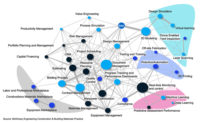Is it too early to start thinking about the 2012 IT Budget? The summer months are a good time to update the three- or five-year IT strategy. For many businesses and CIOs, the “quieter” summer months are the best and often the only chance to schedule longer-term planning and thinking.
We’ve seen some major shifts in technologies over the last few years. Some of these are general technology trends like cloud computing, which has driven down the time and cost of implementing new infrastructure and has given new options for scaling infrastructure “on demand.” There’s the emergence of lower cost tablet computing, which creates new options for equipping a more mobile work force. And then there’s Building Information Modeling technology, which has many potential uses as its adoption and maturity increase in our organizations and those of our partners. So with these and other macro trends, here are three areas where construction CIOs should consider developing a formal viewpoint with both short- and long-term strategies.
- Data and Content Storage — When I talk to CIOs about storage, they are quick to respond with the size of their Storage Area Networks (SANs), growth rates and how they are leveraging both Network Attached Storage (NAS) and SAN strategically. The shift from paper to digital plans, the growing use of BIM file formats and the legal requirements on document archiving are all driving up storage capacity needs. But storage is not just about disk space. CIOs need to build redundancy and disaster recovery into their document storage plans because a lack of access to documents halts productivity. Many CIOs are now working with global, distributed work forces and have increasing needs to share documents with partners. Strategies should take these trends into account and include technologies such as data replication, document management and enterprise search. Also, since both the hardware and software technologies in this space are still maturing, CIOs need both short- and longer-term strategies for handling the increases in document storage and access.
- Collaboration — This leads to the next area, which is the need for better collaboration inside the organization and with partners. CIOs are often the first to see the effects of organizational silos, which lead to wasted effort, diminished quality and lost opportunities. In the construction space, BIM and design-build projects require tighter collaboration between contractor, designer and owner. There are knowledge-sharing needs between members of a project and opportunities to leverage information from project to project. Over the last few years, there has been an explosion of tools to help project team members and enterprises capture and share knowledge, including enterprise 2.0 platforms, document collaboration systems and social CRM. But CIOs need to be responsible for more than just tool selection; they need to take an active role in establishing a culture of collaboration and sharing. As part of a CIO’s strategy, one should consider the need for developing talent, responsibilities and processes that help mature a more collaborative organization.
- Business Intelligence — Business intelligence is not about selecting a BI platform—that’s a means to an end. BI is really about better decision-making and leveraging analytics, governance and talent to make faster, smarter decisions deeper into the organization. A BI strategy should start with a quick question like, “What area in the organization will benefit from better transparency and process in their decision-making?” Starting with that question, a CIO needs a team and an approach to help address the early tactical needs, then look to broaden the scope to other areas of the organization. BI maturity benefits greatly from this kind of agile project management and by looking for quick wins to build up demand and influence broader changes.
Want to look at more? Consider construction site tablets, scaling BIM platforms and CRM integrations as other possible areas.


Post a comment to this article
Report Abusive Comment